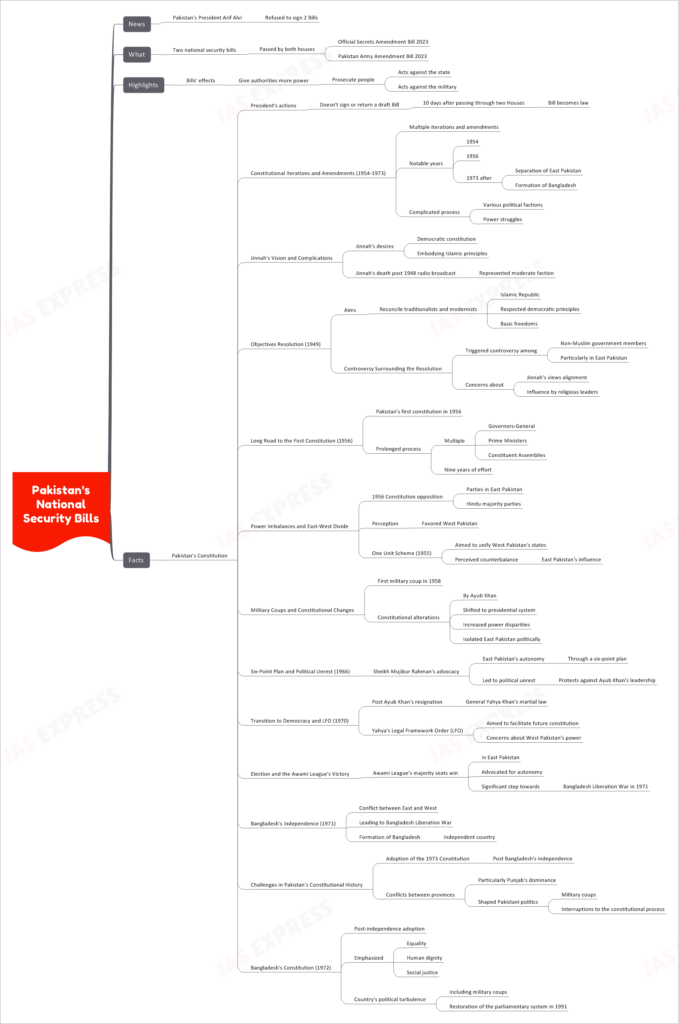Pakistan’s National Security Bills

In recent news, Pakistan’s President Arif Alvi’s refusal to sign two crucial national security bills has sparked significant discussions about the nation’s constitutional history and power dynamics. These bills, passed by both houses, have far-reaching implications for the distribution of authority within Pakistan’s political and military framework.
This topic of “Pakistan’s National Security Bills” is important from the perspective of the UPSC IAS Examination, which falls under General Studies Portion.
What Are the National Security Bills?
Two national security bills, namely the Official Secrets Amendment Bill 2023 and the Pakistan Army Amendment Bill 2023, have been approved by both houses of the Pakistani Parliament. These bills are designed to augment the power of the authorities in prosecuting individuals involved in acts against the state and acts against the military.
Highlights of the Bills
The passage of these bills marks a significant shift in the distribution of power and authority within Pakistan’s governance structure. Key highlights include:
- Increased Authority: The bills provide the authorities with increased power to identify and prosecute individuals engaged in activities deemed detrimental to the state or the military.
- Prosecution: The bills aim to enable the prosecution of individuals who are involved in actions against the state’s interests or actions that undermine the military’s integrity.
The Constitutional Context
Pakistan’s constitutional history is marked by various iterations, amendments, and power struggles that have shaped the nation’s political landscape. Understanding this history is essential to comprehend the context within which these bills have emerged.
President’s Role and Constitutional Iterations (1954-1973)
- President’s Role: According to Pakistan’s constitution, a draft bill must be signed by the President or returned within 10 days after passing through both houses of Parliament. Failure to do so results in the bill becoming law.
- Historical Iterations: Pakistan’s constitutional history from 1954 to 1973 saw multiple iterations and amendments as the nation struggled to find a stable governance structure.
- Jinnah’s Vision: Muhammad Ali Jinnah, Pakistan’s founder, envisioned a democratic constitution embodying Islamic principles.
Objectives Resolution and Controversy (1949)
- Aims of the Resolution: The Objectives Resolution of 1949 aimed to reconcile traditionalist and modernist factions by creating an Islamic Republic that respected democratic principles and basic freedoms.
- Controversy: The resolution sparked controversy among non-Muslim government members, particularly in East Pakistan, due to concerns about its alignment with Jinnah’s views and influence by religious leaders.
Road to the First Constitution (1956)
- Prolonged Process: Pakistan’s first constitution was established in 1956 after a complex and prolonged process involving multiple Governors-General, Prime Ministers, and Constituent Assemblies over nine years.
Power Imbalances and East-West Divide
- Opposition to 1956 Constitution: Parties in East Pakistan and Hindu majority parties opposed the 1956 Constitution, leading to perceptions that it favored West Pakistan.
- One Unit Scheme: The One Unit Scheme aimed to unify West Pakistan’s states but was seen as a counterbalance to East Pakistan’s influence.
Military Coups and Constitutional Changes
- First Military Coup: The first military coup in 1958 led to constitutional alterations by Ayub Khan, including a shift to the presidential system and increased power disparities.
- Six-Point Plan and Political Unrest: Sheikh Mujibur Rahman’s six-point plan for East Pakistan’s autonomy resulted in political unrest and protests against Ayub Khan’s leadership.
Transition to Democracy and LFO (1970)
- Yahya Khan’s Martial Law: After Ayub Khan’s resignation, General Yahya Khan imposed martial law.
- Legal Framework Order (LFO): Yahya’s LFO aimed to facilitate a future constitution but raised concerns about West Pakistan’s power.
Election and Independence
- Awami League’s Victory: The Awami League’s victory in East Pakistan’s majority seats advocated for autonomy, a crucial step toward the Bangladesh Liberation War in 1971.
- Bangladesh’s Independence: The conflict between East and West culminated in the Bangladesh Liberation War and the formation of Bangladesh as an independent country.
Challenges in Constitutional History
- Adoption of 1973 Constitution: The adoption of the 1973 Constitution followed Bangladesh’s independence and was marked by conflicts between provinces and power imbalances.
- Provincial Conflicts: Dominance by Punjab led to conflicts that shaped Pakistani politics, including military coups and interruptions to the constitutional process.
Bangladesh’s Constitution
- Post-Independence Adoption: Bangladesh’s constitution, adopted in 1972 after independence, emphasized equality, human dignity, and social justice.
- Political Turbulence: Bangladesh faced political turbulence, including military coups and the restoration of the parliamentary system in 1991.

